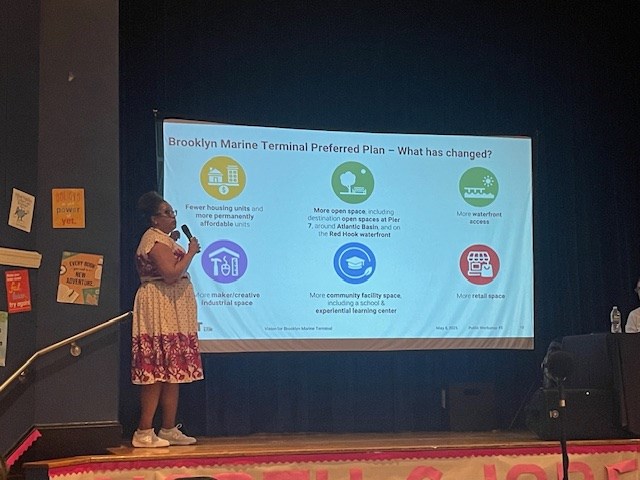Red Hook and Columbia Waterfront residents on Thursday continued to voice their displeasure over the city's housing plan attached to the proposed Brooklyn Marine Terminal redevelopment plan.
During a meeting with the New York City Economic Development Corporation and affiliated project developers, many community members said they were opposed to a plan that could increase the population by more than 20,000 people and would therefore have an impact on transit and infrastructure.
In response to residents’ pushback and concerns from city officials, the Brooklyn Marine Terminal Task Force has delayed its vote, originally scheduled for April 11, until June. The task force is chaired by U.S. Representative Dan Goldman, who was present for most of the public meeting.
“I truly view the task force to be a representative of the community and making sure that in a very complex project, we can include as many priorities of the various communities involved as possible,” Goldman said.

The current proposal includes the city building 7,700 housing units, including 2,695 (or 35%) classified as affordable, based on 60% of the Area Median Income (AMI), to support financing for the BMT site.
Residents expressed outrage at the scale of the plan.
“You’re talking about adding 24,000 people to this neighborhood. You’re blowing this neighborhood up,” said James Morgan, a Columbia Waterfront resident of 30 years.
The 7,700-unit proposal is actually a scaled-back plan, where one early city proposal called for building 13,000 units.
“This has been a very iterative process. There’s been material that we took to the task force and got comments back. There’s material that we took to all of you and got comments back. For example, we’ve included fewer housing units,” said Mikelle Adgate, senior vice president of Government and Community Relations at the EDC.
EDC officials defended the current number of units, citing the need for additional funding to cover redevelopment costs.
“When you have disinvestment and lack of maintenance on a maritime facility, it becomes very expensive to revitalize it. We already have about $350 million in public money that’s been accumulated for this project,” said David Lowin, a senior vice president, Asset Management division at the EDC.
Despite public investment, Lowin said the project would not be feasible without the housing component. “We have looked very closely at alternatives, and the level of funds that are required cannot be generated through other uses,” he said.
Residents also raised concerns about the cost of the affordable units. “Sixty percent AMI is not a small number. It’s not what most people would think it is,” Morgan said.
While most constituents conveyed dismay over the proposal, a few community members voiced support for increased housing while acknowledging that the current plan does not meet the neighborhood's needs.
“A lot of our buildings were built in the 1800s. They don’t meet the standards anymore. We do have to think about how we’re going to build new and build smart,” said Karen Blondel, a public housing advocate who has lived in the area for 40 years.
Speakers also questioned the project's potential impact on transportation. The plan outlines the creation of a “blue highway” system, transporting goods via the revitalized waterfront to reduce truck traffic. Luis E. Cato, a candidate for City Council District 38, expressed skepticism about the system’s short-term efficacy, particularly in the wake of large potential population growth in the area.
“While the highway comes to fruition in a hundred years, I’d posit that most of the cargo will still have to be moved by trucks. We already have trucks from the Marine Transfer Station, trucks from IKEA, trucks from the BQE (Brooklyn Queen-Expressway). How are we actually going to get the promised amendments and improvements to mass transit?” Cato questioned.
The next public workshop with the EDC is scheduled for May 13.




